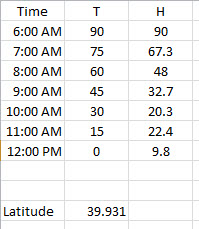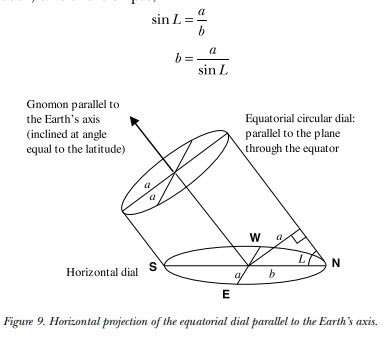Sundials are classified into a number of different types, mainly by the plane in which the dial lays…horizontal, vertical, equatorial, polar, etc. Some types are more challenging to make particularly those designed to be used at odd angles.
It is easy to go to the Internet and order a garden type sundial. If you do and set it up, you’ll find that it doesn’t perform very well versus the clock on your kitchen wall. Sundials could tell time so accurately that they were used into the twentieth century.Make at least three kinds of sundials, one of which is pocket sized. You are encouraged to do the actual geometric construction of the dial rather than printing one that is already laid out. The sundials should be designed for your particular latitude and use corrections needed to tell accurate time by applying longitude, equation of time, and daylight savings time corrections. Test your sundials using your north marks and apply the needed corrections. Compare your results to a watch.
Results (in Yellow)
The Sundial Primer contains lots of useful information for making and adjusting sundials for your latitude and longitude.
Sundail Face Geometry and Calculations
1. Portable (Pocket) Sized Diptych Sundial
Reference
Make a Simple Diptych Pocket Sundial
Make a 16th Century Pocket Diptych Sundial
Results
2. Horizontal Sundial
These are my calculations for my home at 1425 Snowberry Lane, Broomfield, CO, Latitide 39.931 degrees. In the Sundail Face Geometry and Calculations document, page 18,I used the following equation for the separation of the hour lines on the dial, seen in column H of the above table.
To make the Gnomon:
Horizontal Sundial Results - Observational results using my Horizontal Sundial
3. Equatorial Sundial
Equatorial Sundial Results - Observational results using my Equatorial Sundial
Construction of mechanical clocks is beyond the means of most of us, but they were in use during the later parts of the period this program covers. One such surviving clock is in Prague, Czech Republic. The clock was started in 1410 and should be viewed, if not in person at least via the Internet here: http://www.wijzerweb.be/prague.html. The information it provides beyond time is astounding.
My Dad and I visited Prague, Czech Republic, got separated from out tour group and stumbled upon this clock by accident on June 11, 2013. We at lunch at an outdoor restaurant just across the street from this clock (where this picture was taken). We watched the clock do a few cycles and it was fascinating all that it did with each time it was active.
It was at one end of this large plaza area, nearest to the Charles River.



